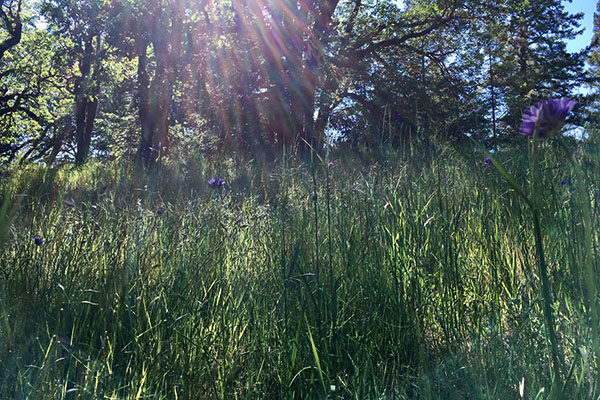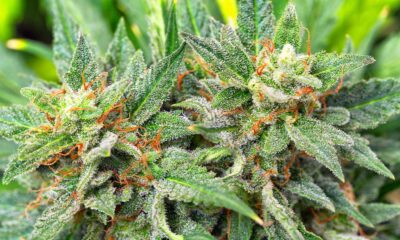
Joint Opinions
The Drought Days Are Over
Reflections on the challenges of growing outdoor cannabis.
It may sound trite, but really, what a difference a year makes. Last year at this time, the meadow and hillsides were already golden, after several years of drought when they never truly turned green. Wildflowers were sparse and the deer looked hungry. The creeks were mostly stepping stones along the dry bed… perhaps a few greenish pools of murky water lingered from early winter rains. A general sense of dryness prevailed, and no one even dared mention the word “fire.”
As summer wore on with relentless days of blazing sun shining on the cannabis, Swami cleverly found new ways to keep the water pipes running to feed them. Our small lake is almost a mile away from the garden, up and down a hill or two, but luckily it ends up being about 10 feet higher elevation than the garden — just enough to be able to employ gravity as the pump. We rationed out spring water for household purposes and had to forego watering basically anything but the cannabis. Such are the sacrifices which must be made on a farm.
Harvest drew near and we prepared the drying and trimming spaces pretty much the same as we had in recent past years. The plants were closely observed, and when deemed ready, the first came in. But with that plant came the rain and it didn’t stop until last week. No one was prepared for it and hasty arrangements were made at every farm to create spaces friendly to processing wet crops. The drought years may have been tough on water usage, but they did guarantee a warm and dry harvest season, ideal for cannabis. But there are no guarantees in farming, are there?
I have heard that some cannabis farmers lost their entire crops to various pathogens last year, so we are lucky to only have seen a portion of the crop turn moldy. Trimming required extra close inspection for anything that looked suspicious — in the business we call it having “moldar.” Curiously, and I have seen this in the past, the quality of the plants is often improved when they are tortured a little. Our beauties had been drenched in the heavy harvest rains, yet the survivors are superb and cured perfectly.
The rains continued and continued, until part of our meadow literally became a lake from over saturation. Yet no one dared complain, as returning to the drought would be a deadly curse. The wood stove cranked out dry heat all winter, while the rain kept us indoors and cozy. Although, by about March, I do admit some cabin fever was setting in. The occasional dry day would bring everyone out to play in the garden and do what could be done, knowing the downpour would return the next day. But again, no one complained. In fact, the old-time locals were all saying that “it is just like the old days, the real Mendocino winters.” I believe that, same as when they say the salmon were so thick in Blue Rock Creek that you could walk across it on their backs.
The “Farmer’s Almanac,” the Bible to people like us, predicts a similar season come next harvest. Maybe even more rain, they say. So a big topic of conversation has been how to prepare properly for that. The Mendocino County building code says no employees can go into a building which is not fully permitted, so the drying shed must either be permitted or in a portable container, for example. At least that’s what we have figured out so far — it is all a guessing game at this point. We want to do it all correctly, up to code in every way, but the codes keep changing! I have even heard a rumor that the department of building and planning may implement a new code for buildings specifically used to dry cannabis, which would demonstrate a thoughtful solution.
Farming used to be so simple without all the regulations, even though the threat of flood, drought, bugs and so much more has always been present. Before Monsanto wanted to tell people what seeds to grow and what fertilizers to use, everything grew naturally. Granted, the labor was difficult using pre-modern tools, but the outcome was what we proudly call an “heirloom” tomato, for example. The circle becomes complete now that regenerative farming methods are being rediscovered by diligent cannabis farmers. Down with the deadly chemicals and up with living soil!
It’s a whole new ball game so far this season. The ground is still moist and the meadow fluorescent green, dotted with various shades of wildflowers. I know we’ll have to mow it, but not quite yet, the flowers are too pretty. The cannabis plants are going into the ground at last, spreading their small arms to the sun, anxious to grow and flourish. The air seems extra humid, as the moisture in the earth continue to evaporate. All the animals seem delighted to enjoy the tasty greens everywhere, whether tender little oak leaves or lush thick natural grasses. Turtles and frogs frolic in the creeks and lake — not to mention the loud frog who lives in the wall of our kitchen and sings us a song every night!
It is a wonderful thing to observe the ranch come to life every year at this time. Various vegetables and companion plants have been planted along with the cannabis and soon the gardens will burst with color and life. The same goes for the people who live here. Like turtles, we have emerged from our winter shells, sweaters have been replaced by T-shirts and we have migrated to the “outside living room.” Summer has come at last. Festivals have begun and farmers markets welcome shoppers to purchase everything from fruits and veggies to cannabis.
The drought may have vanished, but climate change is for real. And so we watch the weather and pray for the best. It certainly would be nice if the rains held off until post harvest this year, but we’ll take what comes and be grateful. It is all a blessing, just to be alive.
TELL US, have you ever tried to grow cannabis?

























